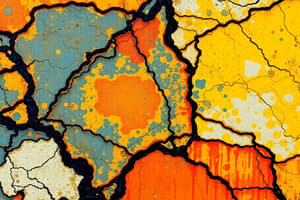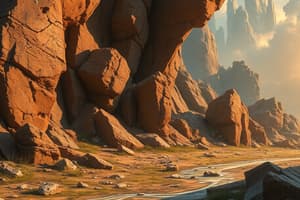Podcast
Questions and Answers
Define and give examples of the two kinds of weathering.
Define and give examples of the two kinds of weathering.
Mechanical Weathering - Physical breakdown of rocks (e.g., Frost Action, Thermal Expansion/Contraction). Chemical Weathering - Chemical alteration of the parent material in rocks (e.g., Oxidation, Hydrolysis).
How does physical weathering influence chemical weathering?
How does physical weathering influence chemical weathering?
Physical weathering divides rocks into smaller pieces, which have a larger surface area, leading to faster chemical weathering.
Name and give examples of the major kinds of chemical weathering.
Name and give examples of the major kinds of chemical weathering.
Oxidation (e.g., Iron Oxide), Dissolution (e.g., dissolving carbonic acid with water), Hydrolysis (e.g., chemical alteration of K Feldspar Orthoclase).
What are the main products of weathering?
What are the main products of weathering?
What are the differences between the characteristics and environments of pedocals and pedalfers?
What are the differences between the characteristics and environments of pedocals and pedalfers?
How do parent materials affect the kinds of soils in North Central Texas?
How do parent materials affect the kinds of soils in North Central Texas?
Define and give examples of the three main kinds of sedimentary rocks.
Define and give examples of the three main kinds of sedimentary rocks.
Describe the main processes that cause lithification. What are the main kinds of cement?
Describe the main processes that cause lithification. What are the main kinds of cement?
What processes distinguish an 'immature' from a 'mature' sandstone?
What processes distinguish an 'immature' from a 'mature' sandstone?
What rocks do you expect in the following sedimentary environments: river channel, beach, dunes, shallow shelf, deep shelf?
What rocks do you expect in the following sedimentary environments: river channel, beach, dunes, shallow shelf, deep shelf?
How does the principle of uniformitarianism help us interpret past sedimentary environments?
How does the principle of uniformitarianism help us interpret past sedimentary environments?
How is metamorphic 'grade' determined from foliated metamorphic rocks?
How is metamorphic 'grade' determined from foliated metamorphic rocks?
Define and give two examples of a non-foliated metamorphic rock.
Define and give two examples of a non-foliated metamorphic rock.
What's a protolith? Give an example of a foliated and a non-foliated metamorphic rock and their protoliths.
What's a protolith? Give an example of a foliated and a non-foliated metamorphic rock and their protoliths.
How are metamorphic rock types arranged about an Andean-type mountain core? Why does this pattern occur?
How are metamorphic rock types arranged about an Andean-type mountain core? Why does this pattern occur?
Beginning with a shale, define the changes in metamorphic rocks that are formed during regional metamorphism, from low grade to high grade.
Beginning with a shale, define the changes in metamorphic rocks that are formed during regional metamorphism, from low grade to high grade.
What's contact metamorphism? How and under what tectonic conditions does it happen?
What's contact metamorphism? How and under what tectonic conditions does it happen?
Flashcards are hidden until you start studying
Study Notes
Weathering Types
- Mechanical weathering involves the physical breakdown of rocks, exemplified by frost action and thermal expansion/contraction.
- Chemical weathering leads to the chemical alteration of rock materials, as seen in processes like oxidation and hydrolysis.
Influence of Physical Weathering on Chemical Weathering
- Smaller rock pieces resulting from physical weathering have a larger surface area, which accelerates chemical weathering.
Major Kinds of Chemical Weathering
- Oxidation occurs when oxygen reacts with minerals to form oxides, such as iron oxide.
- Dissolution is the process where substances, like carbonic acid, dissociate into ions, contributing to water's acidity.
- Hydrolysis is characterized by hydrogen ions replacing other positive ions in minerals, altering rocks like K Feldspar Orthoclase.
Weathering Products
- The main products of weathering include clay minerals, oxides, ions in solution, and residual quartz.
Pedocals vs. Pedalfers
- Pedocals (Mollisols) are found in deserts and prairies, characterized by lower rainfall and the accumulation of calcium carbonate.
- Pedalfers (Alfisols) develop in forested areas with higher rainfall, often exhibiting red B horizons and leaching of aluminum and iron oxides.
Parent Materials and Soil Types in North Central Texas
- Located in North Central Texas, soils consist primarily of sandy, calcareous forest soils influenced by "cross timbers" prairie vegetation, along with issues of expansive clay.
Types of Sedimentary Rocks
- Detrital rocks consist of lithified sediments, like breccia.
- Crystalline rocks form from crystallized minerals, such as limestone.
- Biochemical rocks arise from the activities of organisms, with coquina as an example.
Lithification Processes
- Compaction involves the removal of water and the pressing together of sediment grains.
- Cementation occurs when minerals precipitate into pore spaces, binding sediment together; common cements include quartz, calcite, and hematite.
Immature vs. Mature Sandstone
- Marine transgressions and regressions depict the shifting environments of sediment deposition, helping to classify sandstones as immature or mature.
Expected Rocks in Sedimentary Environments
- River Channels typically have arkose due to angular grains from limited transport.
- Beaches are home to sandstone, formed from high-energy transport of sand.
- Dunes also yield hematite based on similar transport conditions.
- Shallow shelves deposit shale due to weak currents, while deep shelves produce limestone, requiring sunlight and biological activity.
Principle of Uniformitarianism
- This principle allows scientists to infer past sedimentary environments by comparing ancient rock features with those in modern settings.
Determining Metamorphic Grade
- The "grade" of foliated metamorphic rocks is assessed by texture, with fine-grained indicating low-grade and coarse-grained indicating high-grade.
Non-Foliated Metamorphic Rocks
- Non-foliated metamorphic rocks lack a preferred mineral orientation, with marble (from limestone) and quartzite as examples.
Protolith Definition
- A protolith is the original rock from which metamorphic rocks evolve. For instance, slate originates from shale, while marble originates from limestone.
Arrangement of Metamorphic Rock Types
- In an Andean-type mountain core, the arrangement is predominantly high-grade metamorphic rocks, indicating intense pressure and temperature conditions.
Changes in Metamorphic Rocks from Shale
- Regional metamorphism transforms shale into slate, phyllite, schist, and eventually gneiss, reflecting increasing metamorphic grade.
Contact Metamorphism
- Occurs when magma intrudes and alters the surrounding rocks, usually at tectonic plate boundaries.
Studying That Suits You
Use AI to generate personalized quizzes and flashcards to suit your learning preferences.




